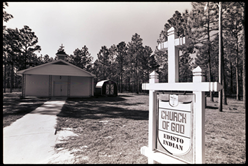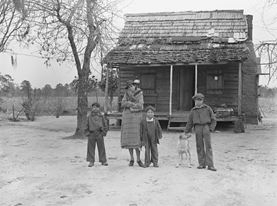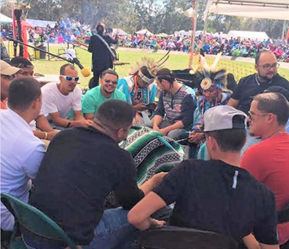» Edisto Natchez Kusso by Mateo Mérida

Despite not having the legal recognition to have a reservation, today the Edisto Natchez-Kusso have seen many of the same social problems commonly associated with Indigenous reservations and face many of the same appalling racial disparities and descendants of enslaved Africans. After the Civil War and Reconstruction, the rise of the Jim Crow legislation meant segregation devastated the Natchez-Kusso people. Like African Americans, Natchez-Kusso children were forced to go to understaffed and under-resourced Indian-only schools, restricting their access to quality education and upward mobility. The Four Holes Indian School was the last Indian school in operation in South Carolina, closing its doors in 1969. Today, the Edisto Natchez-Kusso continue to be impacted by a legacy of colonization, slavery, racism and white supremacy, all of which underscore the importance of federal recognition for the tribe.
The Kusso initially lived in present-day Beaufort County, South Carolina. In 1566, the Spanish attempted to establish the Santa Elena colony to serve as the capital of Spanish Florida, right outside of Kusso lands. Resenting the presence of these occupying forces, the Kusso constantly raided Santa Elena, and in return were regularly antagonized by the Spanish and their native allies. Eventually, in 1587, due to constant provocation by the Kusso and other Indigenous groups, the Spanish abandoned Santa Elena to focus on their other North American colonial base to the south at Saint Augustine. Nearly a century later, in 1670, the English settled Charles Towne just 100 miles to the north (on the lands of the Kiawah and Sewee people).
Given their prior interactions with Europeans, the Kusso recognized the potential danger to their lands and way of life by living in such proximity to the English and, as a result launched several violent skirmishes against them. In response, and to solidify their control over the region, in 1675 the English mandated that the Kusso surrender their lands, forcing them to relocate inland. By then, the Kusso population had been reduced to roughly 25 people and were in a state of duress. After negotiation, the Kusso were granted land somewhere along the banks of the Pon Pon River. Although the reservation’s precise location is not known, it is believed to have been somewhere within the Four Hole Swamp watershed on the present-day Edisto River.
1000 miles away, in the Louisiana Territory, another Indigenous American community, the Natchez, were also actively fighting against French occupation of and displacement from their lands. As a result of periods of reciprocated violence with French colonizers, beginning in the 1720’s, groups of Indigenous people from the interior of Louisiana were forced eastward into the Carolinas. The Natchez originally settled among the Cherokee of present-day Western North Carolina, South Carolina, and Northern Georgia. Around 1734, a small group of roughly 50 Natchez left the Cherokee and were welcomed to live among the Kusso people in Four Holes Swamp. When the Natchez arrived at Four Holes, they would have seen swamplands that had been virtually untouched by the rapidly changing colonial world. In their own lifetimes, the Natchez would have watched as sacred forests, bayous, and burial grounds were destroyed to make way for sprawling French sugar plantations. Thus, to them, Four Holes Swamp, with its ancient trees and abundance of natural resources might have been seen as a haven to the Natchez and their Kusso hosts, and ultimately, it proved to be just that. Another group of Natchez migrated to Four Holes in 1747 and the Natchez-Kusso community came into being (Edisto would be added to their name over 200 years later due to the association of their settlement to the Edisto River).
After the Revolutionary War (1776-1783), Indigenous land holdings became more at risk of seizure by the United States government. In response, several Indigenous Confederations worked carefully to abide by Western ways and practices, adopting republican style governments, constitutions, and legal systems. That mattered little however, when Andrew Jackson became president in 1829 forcibly removed Indigenous people from the Southeast westward to territory in present-day Oklahoma as a part of his Indian Removal Act (1830). While populous groups, like the Tsalagi, Seminoles, and Muskogees were forced to relocate to Indian Territory during what is often referred to as the Trail of Tears, the married communities of the Natchez-Kusso continued to occupy the lands promised to them by the English, thanks in part perhaps to their small numbers and the isolated locale of Four Holes Swamp. Though the British previously recognized their status and reservation within their colony, the new American government did not. As a result of the precarious status of their community, during the Antebellum period, the Natchez-Kusso would have had a complex relationship with enslaved Africans in and around Four Holes Swamp as both groups depended on the haven and natural resources Four Holes provided.

Four Holes Swamp did not only offer refuge for displaced Indigenous communities, but it also offered shelter for freedom seeking African Americans as well. As the only old growth swamp remaining in South Carolina, Four Hole’s dense forests and numerous waterways was a safe haven for people who chose to emancipate themselves from their oppression in the plantations. James Matthews, an enslaved person who took refuge in Four Holes Swamp, descries “It is very common for slaves to run away into the woods after being badly whipped. They are forced to, for they cannot do their tasks, and so they have to stay in the woods till they get well. Sometimes they stay there five or six weeks till they are taken or driven back by hunger.” While it was common for enslaved people to flee to the swamps, they would not have been alone in Four Holes.1

Very little evidence exists documenting the interactions between the Natchez-Kusso and neighboring maroon settlements encamped at Four Holes Swamp. Did the Natchez-Kusso provide them shelter? Did they intermarry with one another? Did they see a common enemy in the Europeans and agree to fight as one community in the event of an attack? Did they see the freedom seekers as reliable trade partners and did their knowledge of the local waterways make them an asset to the Natchez-Kusso? Or, on the other hand, did the Natchez-Kusso see the constant encroachment of freedom seekers into Four Holes as a threat to their survival, considering they attracted groups of armed white militias into the area seeking to capture and return them to slavery? Were the Natchez-Kusso pressured to serve as slave catchers to prevent further tension with the local government? When it comes to the interactions between the Natchez-Kusso and maroon communities of Four Holes Swamp, there are currently more questions than answers. More research is necessary to develop a clearer picture of the relationship between the two groups.
Despite not having the legal recognition to have a reservation, today the Edisto Natchez-Kusso have seen many of the same social problems commonly associated with Indigenous reservations and face many of the same appalling racial disparities and descendants of enslaved Africans. After the Civil War and Reconstruction, the rise of the Jim Crow legislation meant segregation devastated the Natchez-Kusso people. Like African Americans, Natchez-Kusso children were forced to go to understaffed and under-resourced Indian-only schools, restricting their access to quality education and upward mobility. The Four Holes Indian School was the last Indian school in operation in South Carolina, closing its doors in 1969. Today, the Edisto Natchez-Kusso continue to be impacted by a legacy of colonization, slavery, racism and white supremacy, all of which underscore the importance of federal recognition for the tribe.

For decades activists and organizers of the American Indian movement have pushed the federal government to improve the material conditions of all Indigenous people in the United States. Federal recognition means legal protections, financial subsidies, and resource allocations to tribal governments, which could substantially improve the quality of life for the Edisto Natchez-Kusso community, who have been pursuing tribal recognition in the 1960’s. They were recognized by the state government of South Carolina first in 1987, and again in 2010. In November of 2021, Representative Nancy Mace introduced a bill for the tribal recognition of the Edisto Natchez-Kusso, which still has yet to be voted on.
The Avery Research Center, The College, and Charleston as a whole sit on the lands once occupied by several non-sedentary ethnic communities, known contemporarily as Cusabos. Little information still exists which discusses who Cusabos were, and even less exists today that was written by these Cusabos themselves. Many regions throughout Charleston retain the names given to them by these various tribes, such as the Kiawah, Sewee, Stono, Wando, Wappoo, Edisto, and Etiwan people. It is because of their displacement—and ultimate extinction—of these communities, that the Lowcountry, as it is understood was able to take shape, laying the foundation for plantation slavery, which defined the lives of enslaved people, who would become the racial majority of people in South Carolina in the antebellum period.2 For hundreds of years, the Edisto Kusso Natchez have called the watersheds of the Edisto River home, and continue to hold a lasting presence to this day. Oftentimes, the narratives of the Lowcountry treat Indigenous people as agents of the past. Instead, the Edisto Kusso Natchez show that the history of Indigenous people in South Carolina not only persists but stands as a unique model of adaptability and perseverance and shows how the lives of Black and Indigenous people have mutually influenced one another.
Sources
- Susanna Ashton and Robyn E. Adams, et al., eds., I Belong to South Carolina: South Carolina Slave Narratives (Columbia: University of South Carolina, 2010), 49-82.
- Wood, Peter H. Black Majority: Negroes in Colonial South Carolina From 1670 Through the Stono Rebellion. Alfred A. Knopf: New York, NY. 1974.
Image Credit
- “The History of Kiawah & More” Kiawah Island. Charleston, SC. 2022. Accessed Dec. 7, 2022. https://www.kiawahisland.com/island-life/island-insights/
- Crediford, Gene. “Edisto Indian Church of God.” Native American South Carolina Archive. 1985. Accessed Dec. 7, 2022. https://www.nativesouthcarolina.org/images/1278
- Wolcott, Marion Post. “Indian (mixed breed–“brass ankle”) family near Summerville, South Carolina.” Library of Congress: Washington, DC. Dec., 1938. Accessed Dec. 7, 2022. https://www.loc.gov/pictures/item/2017799834/ [Note: The family in the image are members of the Wassamasaw Tribe]
- “Gallery.” Natchez-Kusso Tribe of South Carolina official site. Accessed Dec. 7, 2022. https://www.natchezkussotribeofscedisto.website/gallery
Bibliography
- Brown, Vicki. “Edisto Natchez-Kusso move closer to federal recognition.” Walterboro Live: Walterboro, SC. Jan. 27, 2022. Accessed Dec. 7, 2022. https://walterborolive.com/stories/edisto-natchez-kusso-move-closer-to-federal-recognition,38580
- Butler, Nic. “The First People of the South Carolina Lowcountry.” Ep. 220. Charleston Time Machine. Charleston County Public Library: Charleston, SC. Nov. 19, 2021. Accessed Dec. 7, 2022. https://www.ccpl.org/charleston-time-machine/first-people-south-carolina-lowcountry
- Crediford, Gene J. “Chapter 4: The Edistos” in Those Who Remain: A Photographer’s Memoir of South Carolina Indians. University of Alabama Press: Tuscaloosa, AL. 2009.
- Dahlman, Michael. “Native Americans.” Daniel Island Historical Society: Daniel Island, SC. Nov. 9, 2011. Accessed Dec. 7, 2022. https://dihistoricalsociety.com/native-americans/
- Mace, Nancy. H.R.5822 – To extend Federal recognition to the Edisto Natchez-Kusso Tribe of South Carolina, and for other purposes. U.S. House of Representatives. Nov. 2, 2021. Accessed Dec. 7, 2022. https://www.congress.gov/bill/117th-congress/house-bill/5822/text
- “KUSSO-NATCHEZ INDIANS – NATIVE AMERICANS IN SC.” SCIWAY: Columbia, SC. 2022. Accessed Dec. 7, 2022. https://www.sciway.net/hist/indians/kusso_natchez.html
- McAmis, Herb. Indian People of the Edisto River: a brief history of the Kusso – Natchez Indians, often called “Edistos”. Publisher unknown. 1990-9.
- Natchez-Kusso Tribe of South Carolina official site. Accessed Dec. 7, 2022. https://www.natchezkussotribeofscedisto.website
- Sanford, Mark. “Governor’s Proclamation of Native American Heritage.” State of South Carolina. Nov., 2004. Accessed Dec. 7, 2022. https://dc.statelibrary.sc.gov/bitstream/handle/10827/4400/GOV_Proclamation_Native_American_Heritage_2004-11.pdf?sequence=1
- Smyth, Edward Noel. “The Natchez Diaspora: A History of Indigenous Displacement and Survival in the Atlantic World,” dissertation. University of California, Santa Cruz: Santa Cruz, CA. Sep., 2016. Accessed Dec. 7, 2022. https://www.proquest.com/docview/1834008876?pq-origsite=gscholar&fromopenview=true
- Waddell, Gene. Indians of the South Carolina Lowcountry, 1562-1751. University of South Carolina: Columbia, SC. 1980.
